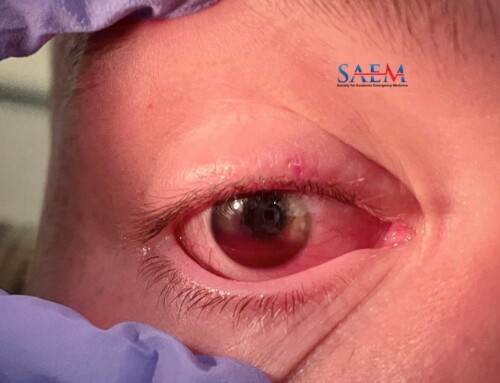
A bottle of nail glue and timolol eye drops (reproduced with permission from BMJ Publishing Group Ltd [1])
Background rise of artificial, press-on nails
Artificial acrylic or “press-on” nails were first invented in the 1950s; however, they did not gain in popularity until the 1980s as nail art became a trend [2]. Shortly thereafter, they fell out of style until a resurgence occurred with the COVID pandemic forcing the closure of nail salons. Compared to pre-pandemic values, Google searches for “press on nails” increased 300% [3]. Application of most nails requires nail glue, which often contains a mixture of alcohol, cyanoacrylate (superglue), or photo-bonded methacrylate [4].
Nail glue complications
Use of nail glue at home can result in adverse exposures with the most common location being the eye [5]. Because nail glue is often packaged in small containers identical to eye drop bottles, patients can mistake the nail glue for ophthalmic drops — especially those with visual impairment [6]. This exposure was first described in the medical literature in 1982 and has been described many times since despite repeated calls for manufacturers to modify the bottles to be safer [1].
In the presence of water, cyanoacrylate rapidly polymerizes, leading to the bonding effect [5]. If the glue gets into a person’s eye, reflexive blinking pushes the glue to the eyelid margins resulting in the eyelashes or eyelid margins sticking together [5], also known as inadvertent tarsorrhaphy. Methods to open the eyelids include removal of glue with forceps, removal or cutting of the eyelashes, or soaking the eye for hours to days with a moist gauze [1, 6, 7].
Although the most successful solvent to dissolve dried glue is acetone, this can cause corneal and conjunctival injuries [8]. The effectiveness of other solvents has been debated in the literature with mixed reports of efficacy [9].
Trick of the Trade: Apply petroleum-based topical antibiotic ointment
Our personal experience managing several of these cases suggests that a petroleum-based topical antibiotic ointment, such as Bacitracin, can help loosen the glue bond. It is an inexpensive option with minimal harm to fix inadvertent eyelid adhesion from nail glue (or other superglue). It is worth trying before attempting more aggressive techniques.

Before and after application of topical antibiotic ointment to remove inadvertent nail glue causing eyelid adhesion
Materials Needed
- Bacitracin ointment (1-2 tubes)
- Cotton-tipped applicatiors (Q-tips)
Technique
- Apply the topical ointment liberally to the affected eye.
- Let rest undisturbed for 15-20 minutes.
- Gently pull the eyelids and eyelashes apart.
- Be careful not to massage the area too vigorously onto the eye itself, as any residual local glue can result in corneal trauma.
- You can use cotton-tipped applicators to help gently tease the lid margins apart.
- Copiously irrigate the eye.
- Perform an eye exam to assess for ocular injury.
- Consider obtaining an ophthalmology consult.
References
- Yusuf IH, Patel CK. A sticky sight: cyanoacrylate “superglue” injuries of the eye. BMJ Case Rep. 2010;2010:bcr11.2009.2435. doi:10.1136/bcr.11.2009.2435
- Quinn J. Not Your ’80s Press-Ons: Why the Press-On Manicure Trend Is a Must-Try. Sunday Edit. Published June 10, 2022. Accessed October 26, 2022.
- Google Trends on “press on nails”. Google Trends. Accessed October 26, 2022.
- Brambilla E, Crevani M, Petrolini VM, et al. Exposure to Nail and False Eyelash Glue: A Case Series Study. Int J Environ Res Public Health. 2020;17(12):E4283. doi:10.3390/ijerph17124283
- Forrester MB. Characteristics of ocular nail glue exposures reported to the National Electronic Injury Surveillance System during 2000-2019. Clin Toxicol Phila Pa. 2021;59(7):633-638. doi:10.1080/15563650.2020.1834115
- Samet A, Li DQ, Al-Qahtani A, Arthurs B, El-Hadad C. Nail glue injuries to the eye: assessment of two cases. Can J Ophthalmol. 2022;57(1):e11-e13. doi:10.1016/j.jcjo.2021.04.026
- Cohen J. Super Glued Shut. Brown Emergency Medicine. Published Apr 12, 2017. Accessed February 5, 2023.
- Reddy SC. Superglue injuries of the eye. Int J Ophthalmol. 2012;5(5):634-637. doi:10.3980/j.issn.2222-3959.2012.05.18
- Prouty H, Adams DS, Heard K. Evaluation of Treatments for Cyanoacrylate Eyelash Adhesion Using an In-Vitro Model. Cutan Ocul Toxicol. 2008;27(1):11-14. doi:10.1080/15569520701856732






